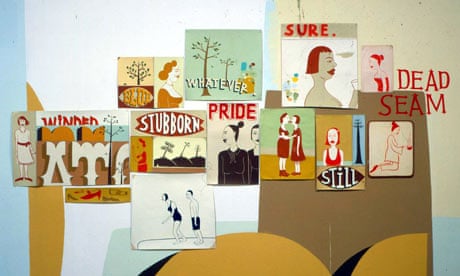In the last months of her life, in 2001, the artist Margaret Kilgallen could be found atop a scissor lift, creating one of her trademark installations for a show at the Institute of Contemporary Art in Philadelphia – a towering, hand-painted streetscape, punctuated with carnival letters and cartoonish figures. She was heavily pregnant. She was also reaching the late stages of breast cancer. "Her determination was amazing," says David Hannah, a professor of art at Stanford University, where she was finishing her master's degree. "I think she knew what was coming, but she was determined to see the pregnancy through, to give birth, and to create this really daunting installation. She had such physical courage. It was incredible."
At 33, Kilgallen was already a widely acclaimed and exhibited artist; speaking to her friends, the image emerges of a woman in perpetual motion, a blur of productivity. "One time I helped her with an installation," says Amy Franceschini, an artist and close friend, "and I was really nervous to make the line perfect. She just said, 'Pretend you're playing tennis – swing and follow through.' She would approach the wall with complete confidence, with a humility and a fierceness, but never fear."
A new documentary, Beautiful Losers, profiles the softly spoken Kilgallen along with 10 other artists who in the 1990s formed a diffuse collective around the New York gallery Alleged. These include Harmony Korine (screenwriter of the film Kids), Mike Mills (director of the film Thumbsucker) and Shepard Fairey (who created the iconic Hope image of Barack Obama). The documentary also profiles the brilliant painter Barry McGee, known as the San Francisco graffiti artist Twist, who married Kilgallen in 1999. Directed by the one-time owner of Alleged, Aaron Rose, Beautiful Losers is a love letter to punk, skateboarding and graffiti, to the joy of turning your garage into a studio, of creating something from nothing. And at its centre is the gentle, disarmingly resolute Kilgallen.
Growing up in the small town of Kensington, Maryland, Kilgallen was introduced to folk traditions such as Amish quilting and banjo playing; she became adept at the banjo herself. After a BA in studio art and printmaking at Colorado College, she moved to San Francisco, where she found inspiration in the city's hand-painted shop signs, later telling the US broadcaster PBS that she liked "things that are handmade. I like to see people's hand in the world, anywhere in the world; it doesn't matter to me where it is."
Kilgallen's productivity was shaped by her graffiti background – she painted hundreds of murals in San Francisco, and made line drawings on freight trains with her tag Matokie Slaughter. As Franceschini says, "That's a situation where, if you worry about what you're doing, you're probably going to get arrested" – a thought echoed by Rose. "Her ability to execute massive installations a) so perfectly, and b) so fast was astonishing. I think that came from her experience on the streets."
In the 1990s, Kilgallen worked at the San Francisco Public Library, "repairing old books", says McGee. "She worked with all these amazing texts, rebinding them and whatnot, and while she had always been making art, that focused her." Typography became a major theme, enormous letters spelling out "Cheat steal lie" or "Kook". And all executed in a distinct palette of reds, yellows and browns, the result of using what she called "oops paint", cheap, badly mixed or discontinued colours. "Everyone was like, 'Ugh! How can you use those ugly colours?' " says Franceschini, "and somehow she made them look amazing."
In Kilgallen's PBS interview, she talks about her sense of art and community, which spurred her on in low moments when "the fact that maybe, maybe, somebody will learn from what I'm doing" was enough to keep her going. Both her art and life were also informed by the belief that women should be more visible. Strong female figures surf, smoke and saunter through the paintings she made on wood and walls. And though she was nervous of public speaking, she would put these fears aside, so a woman could be "visual in our everyday landscape, working hard and doing their own thing".
Kilgallen had been treated for breast cancer before; as far as she and McGee knew, for most of her pregnancy she was in good health. Then, he says, in her seventh month, she sensed something was wrong. A diagnosis took time, and it wasn't until the birth of their daughter, Asha, on 7 June 2001, that she started treatment. Ten days later, she received her master's degree. She had been "making things all the time", says McGee. "Nonstop. A huge output. I think it was because when you're young and making some headway, you just say yes to everything, you're completely consumed by it." On 26 June, Kilgallen died. But not before creating a dazzling, definitive body of work.

Comments (…)
Sign in or create your Guardian account to join the discussion